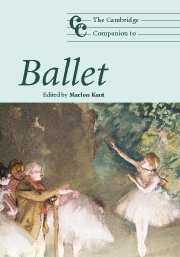Book contents
- Frontmatter
- Introduction
- Part I From the Renaissance to the baroque: royal power and worldly display
- Part II The eighteenth century: revolutions in technique and spirit
- Part III Romantic ballet: ballet is a woman
- 10 Romantic ballet in France: 1830–850
- 11 Deadly sylphs and decent mermaids: the women in the Danish romantic world of August Bournonville
- 12 The orchestra as translator: French nineteenth-century ballet
- 13 Russian ballet in the age of Petipa
- 14 Opening the door to a fairy-tale world: Tchaikovsky's ballet music
- 15 The romantic ballet and its critics: dance goes public
- 16 The soul of the shoe
- Part IV The twentieth century: tradition becomes modern
- Notes
- Bibliography and further reading
- Index of persons
- Index of ballets
- Subject index
- The Cambridge Companion to Music
11 - Deadly sylphs and decent mermaids: the women in the Danish romantic world of August Bournonville
from Part III - Romantic ballet: ballet is a woman
Published online by Cambridge University Press: 28 September 2011
- Frontmatter
- Introduction
- Part I From the Renaissance to the baroque: royal power and worldly display
- Part II The eighteenth century: revolutions in technique and spirit
- Part III Romantic ballet: ballet is a woman
- 10 Romantic ballet in France: 1830–850
- 11 Deadly sylphs and decent mermaids: the women in the Danish romantic world of August Bournonville
- 12 The orchestra as translator: French nineteenth-century ballet
- 13 Russian ballet in the age of Petipa
- 14 Opening the door to a fairy-tale world: Tchaikovsky's ballet music
- 15 The romantic ballet and its critics: dance goes public
- 16 The soul of the shoe
- Part IV The twentieth century: tradition becomes modern
- Notes
- Bibliography and further reading
- Index of persons
- Index of ballets
- Subject index
- The Cambridge Companion to Music
Summary
Is the Sylphide just a dream? Does she only exist as a supernatural being, split between dream and reality, in the thoughts of a romantic hero? Or is she a woman of flirtatious flesh and boiling blood?
There she is with her fragile wings, sitting right next to James in his armchair, shining in her pale whiteness and pointing a symbolic finger under her chin. She is so close that he could feel her fairy breath if he only woke up from his wedding nap in the armchair. When he actually does open his longing eyes, she immediately begins her unspoiled and natural dance of joy – only to vanish up the chimney without any warning the next minute&
As the spectator watches the Sylphide flying around in her beloved Scottish forest, she seems most of all to be an unreachable fairy-tale creature, collecting butterflies and looking at birds nests, just for the fun of it. As she loses her wings and her eyes go blind, with her hands creeping down her trembling arms in catastrophic fear, she is no longer a supernatural creature. At this moment, she is transformed into a mortal creature, conquered by gravity, dying in front of the man whom she loves above anything else in the world.
Silence. Tears. Curtain.
- Type
- Chapter
- Information
- The Cambridge Companion to Ballet , pp. 126 - 137Publisher: Cambridge University PressPrint publication year: 2007
- 1
- Cited by

